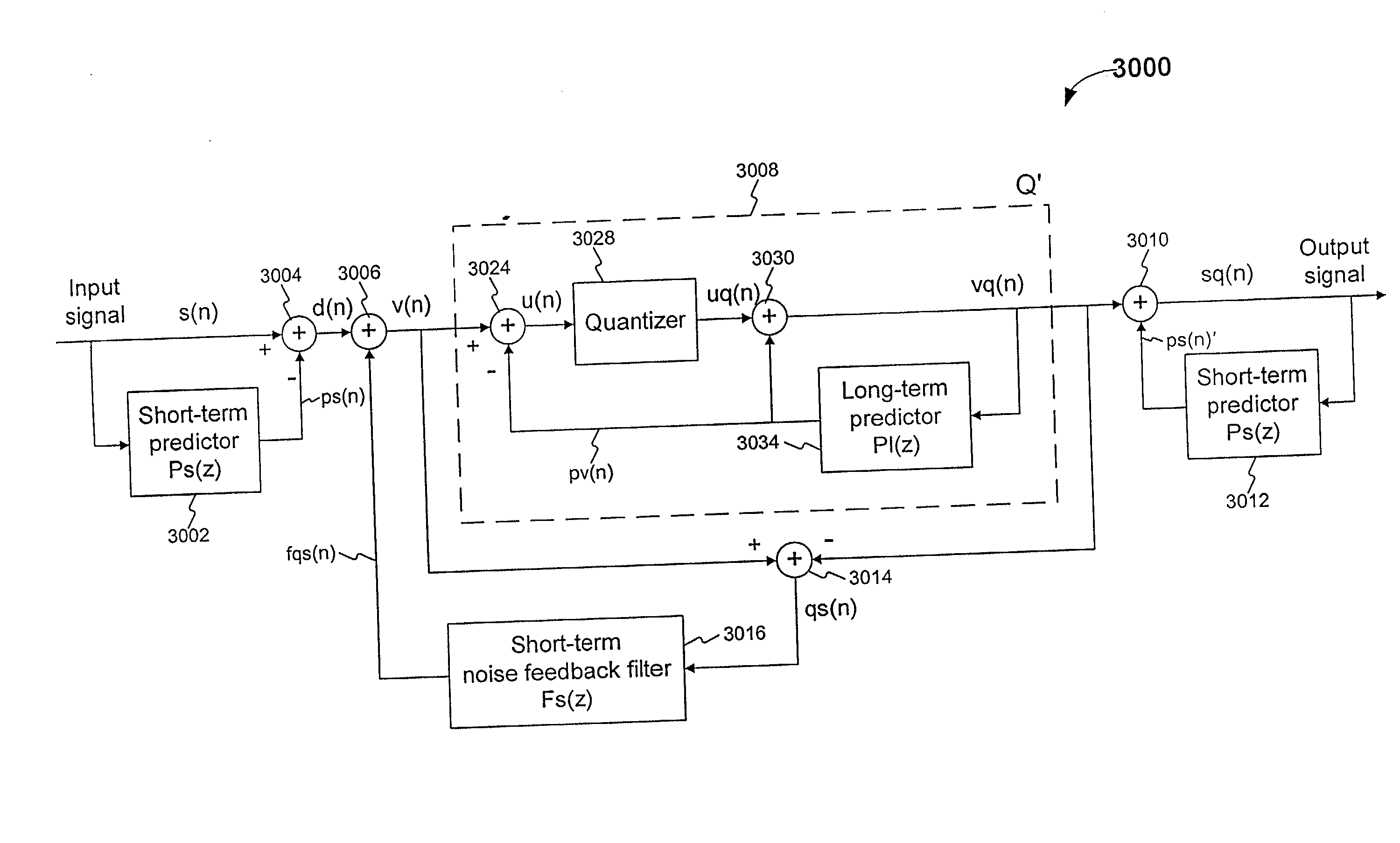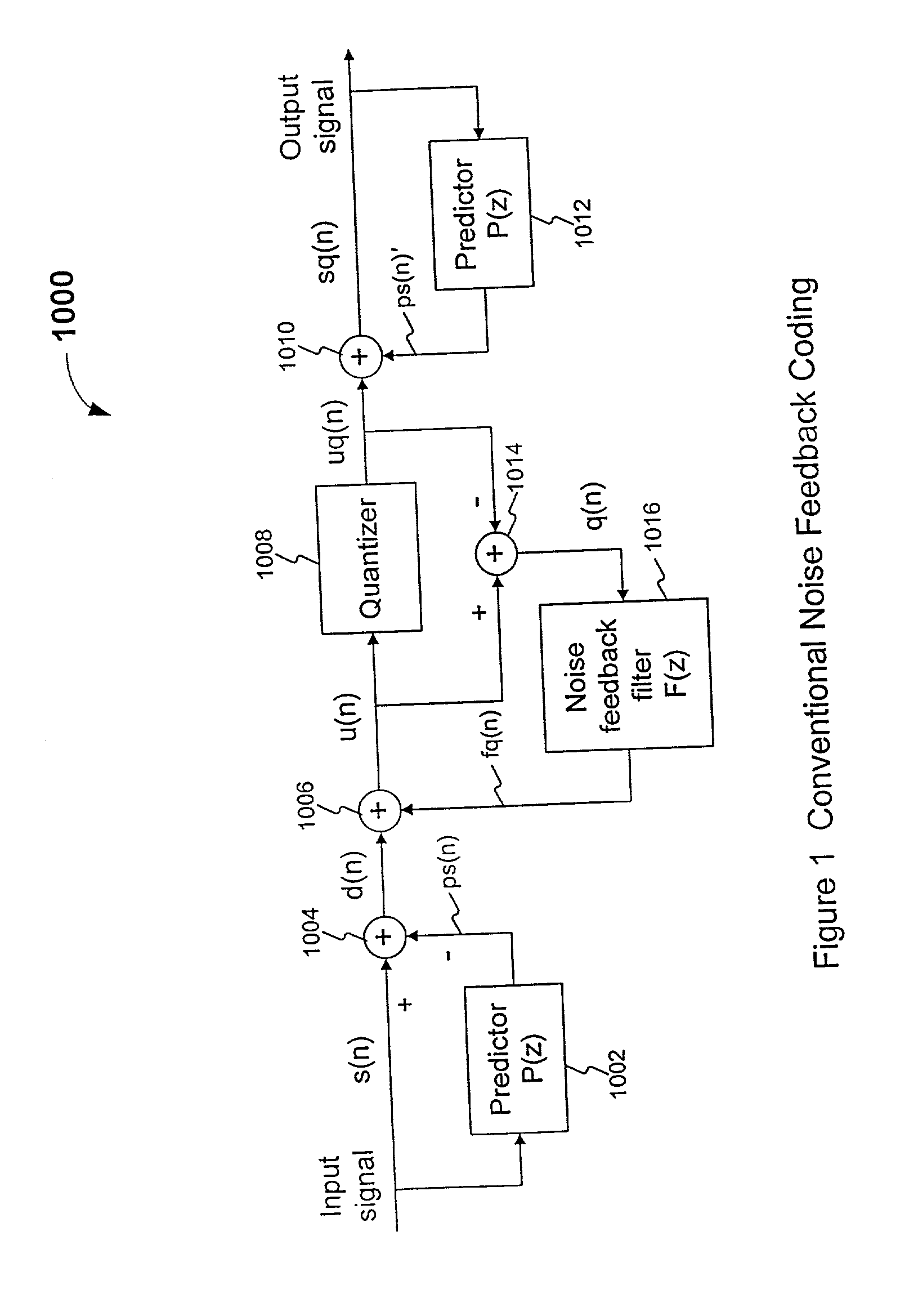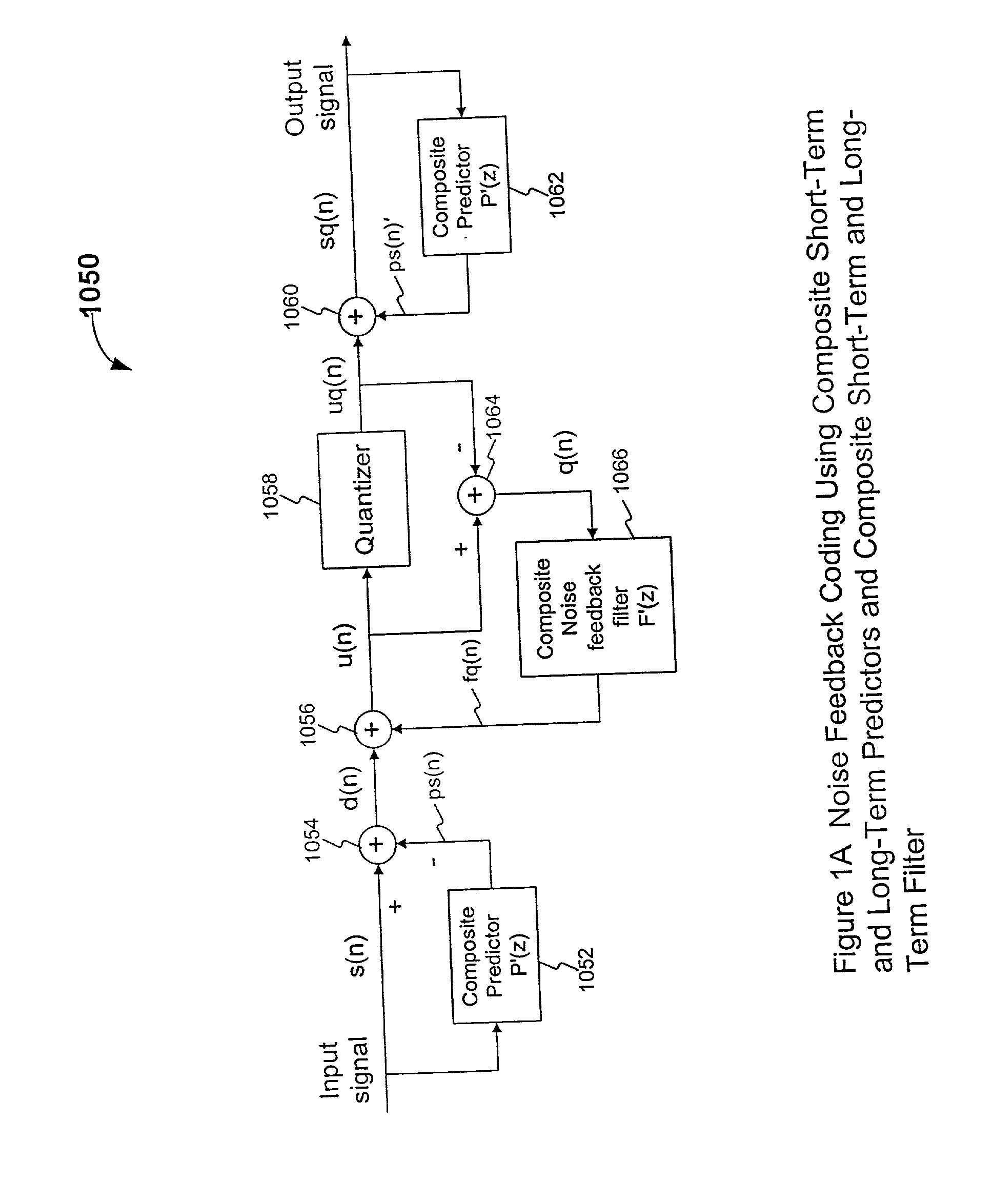[0018] A predictor P as referred to herein predicts a current
signal value (e.g., a
current sample) based on previous or past signal values (e.g., past samples). A predictor can be a short-term predictor or a long-term predictor. A short-term signal predictor (e.g., a short term speech predictor) can predict a current signal sample (e.g., speech sample) based on adjacent signal samples from the immediate past. With respect to speech signals, such "short-term" predicting removes redundancies between, for example, adjacent or close-in signal samples. A long-term signal predictor can predict a current signal sample based on signal samples from the relatively distant past. With respect to a speech signal, such "long-term" predicting removes redundancies between relatively distant signal samples. For example, a long-term speech predictor can remove redundancies between distant speech samples due to a
pitch periodicity of the speech signal.
[0022] Coding a speech signal can cause audible noise when the encoded speech is decoded by a decoder. The audible noise arises because the coded speech signal includes coding noise introduced by the
speech coding process, for example, by quantizing signals in the encoding process. The coding noise can have spectral characteristics (i.e., a spectrum) different from the spectral characteristics (i.e., spectrum) of natural speech (as characterized above). Such audible coding noise can be reduced by spectrally shaping the coding noise (i.e., shaping the coding
noise spectrum) such that it corresponds to or follows to some extent the spectral characteristics (i.e., spectrum) of the speech signal. This is referred to as "
spectral noise shaping" of the coding noise, or "shaping the coding
noise spectrum." The coding noise is shaped to follow the speech signal spectrum only "to some extent" because it is not necessary for the coding
noise spectrum to exactly follow the speech signal spectrum. Rather, the coding noise spectrum is shaped sufficiently to reduce audible noise, thereby improving the perceptual quality of the decoded speech.
[0025] The first contribution of this invention is the introduction of a few novel codec structures for properly achieving two-stage prediction and two-stage noise
spectral shaping at the same time. We call the resulting coding method Two-Stage
Noise Feedback Coding (TSNFC). A first approach is to combine the two predictors into a single composite predictor; we can then derive appropriate filters for use in the conventional single-stage NFC codec structure. Another approach is perhaps more elegant, easier to grasp conceptually, and allows more design flexibility. In this second approach, the conventional single-stage NFC codec structure is duplicated in a nested manner. As will be explained later, this codes structure basically decouples the operations of the long-term prediction and long-term noise
spectral shaping from the operations of the short-term prediction and short-term noise spectral shaping. In the literature, there are several mathematically equivalent single-stage NFC codec structures, each with its own pros and
cons. The decoupling of the long-term NFC operations and short-term NFC operations in this second approach allows us to mix and match different conventional single-stage NFC codec structures easily in our nested two-stage NFC codec structure. This offers great design flexibility and allows us to use the most appropriate single-stage NFC structure for each of the two nested
layers. When these two-stage NFC codec uses a scalar quantizer for the prediction residual, we call the resulting codec a Scalar-Quantization-based, Two-Stage Noise Feedback Codec, or SQ-TSNFC for short.
[0029] The second contribution of this invention is the improvement of the performance of SQ-TSNFC by introducing a novel way to perform
vector quantization of the prediction residual in the context of two-stage NFC. We call the resulting codec a Vector-Quantization-based, Two-Stage Noise Feedback Codec, or VQ-TSNFC for short. In conventional NFC codecs based on scalar quantization of the prediction residual, the codec operates sample-by-sample. For each new input signal sample, the corresponding prediction residual sample is calculated first. The scalar quantizer quantizes this prediction residual sample, and the quantized version of the prediction residual sample is then used for calculating noise feedback and prediction of subsequent samples. This method cannot be extended to
vector quantization directly. The reason is that to quantize a prediction residual vector directly, every sample in that prediction residual vector needs to be calculated first, but that cannot be done, because from the second sample of the vector to the last sample, the unquantized prediction residual samples depend on earlier quantized prediction residual samples, which have not been determined yet since the VQ
codebook search has not been performed. In VQ-TSNFC, we determine the quantized prediction residual vector first, and calculate the corresponding unquantized prediction residual vector and the energy of the difference between these two vectors (i.e. the VQ error vector). After trying every codevector in the VQ
codebook, the codevector that minimizes the energy of the VQ error vector is selected as the output of the vector quantizer. This approach avoids the problem described earlier and gives significant
performance improvement over the TSNFC
system based on scalar quantization. A fast VQ search apparatus according to the present invention uses ZERO-INPUT and ZERO-STATE filter structures to compute corresponding ZERO-INPUT and ZERO-STATE responses, and then selects a preferred codevector based on the responses.
[0030] The third contribution of this invention is the reduction of VQ codebook search complexity in VQ-TSNFC. First, a sign-shape structured codebook is used instead of an unconstrained codebook. Each shape codevector can have either a positive sign or a
negative sign. In other words, given any codevector, there is another codevector that is its
mirror image with respect to the origin. For a given encoding
bit rate for the prediction residual VQ, this sign-shape structured codebook allows us to
cut the number of shape codevectors in half, and thus reduce the codebook search complexity. Second, to reduce the complexity further, we pre-compute and store the contribution to the VQ error vector due to filter memories and signals that are fixed during the codebook search. Then, only the contribution due to the VQ codevector needs to be calculated during the codebook search. This reduces the complexity of the search significantly.
[0031] The fourth contribution of this invention is a closed-loop VQ codebook design method for optimizing the VQ codebook for the prediction residual of VQ-TSNFC. Such closed-
loop optimization of VQ codebook improves the codec performance significantly without any change to the codec operations.
 Login to View More
Login to View More  Login to View More
Login to View More 


